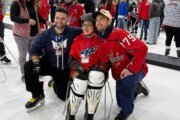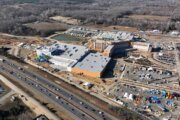Nationals GM for a day: Finding a path back to contention originally appeared on NBC Sports Washington
Welcome to a space where we will try to be reasonable during a somewhat unreasonable task.
Here, the author will be playing general manager for a day, a concept sure to make any general manager, particularly the local one, chuckle.
However, it’s also a good thought exercise when trying to analyze what directions the Nationals can go this offseason in pursuit of the multiple fixes needed after a soiled 2020 season.
The competitive balance tax is set at $210 million for 2021. The Nationals have been under the tax threshold for two consecutive years, meaning they would incur the lowest penalty level (a 20 percent penalty on all overages; for instance, going over by $10 million would incur a $2 million penalty) if they exceed the tax.
How much they are under is difficult to ascertain. Websites with payrolls can be used as a guide, but will not be 100 percent accurate in the end. Spotrac, which will be used here as the reference point, puts the Nationals’ 2021 salary outlay at $141,491,575. That includes three salaries likely to go away: A $10.5 million team option for Adam Eaton, a $12 million team option for Aníbal Sánchez and a $4 million mutual option for Eric Thames. For our purposes, we’ll wipe out those salaries and drop the current payroll to $115 million (to use a round figure).
The Nationals have four arbitration-eligible players: Trea Turner, Erick Fedde, Andrew Stevenson, and Joe Ross. Turner will receive a large raise from his $7.45 million 2020 salary. He’s the number to worry about here. So, we’ll make the cost of this group $15 million; the majority of which is Turner’s salary. Add an estimated $2.5 million for minor-league salaries. All of which leaves a rough number of $132.5 million and $77.5 million before the CBT threshold.
There’s also a gigantic pending wrinkle: Juan Soto could well become arbitration eligible this season, which would launch him from under team control and making the league minimum to around $12 million next season when he sets a new Super 2 record. His eligibility will be determined soon.
Got all that?
For this GM, there are four large holes to fill: third base, corner outfield, fourth starter and (at least) one other bullpen arm. And, for this GM, balance is better than a huge, single cash in. Numerous holes exist with little in-house to work from. Let’s get started.
CLICK HERE TO SUBSCRIBE TO THE NATIONALS TALK PODCAST
Third base
The choice: Justin Turner. He’s been extremely consistent in his 30s: .297/.378/.508. So, Turner has aged well, as Anthony Rendon is likely to do. He also remains a solid defender at third base. The Nationals were 26th in fWAR at third base last year. Turner is a 3-WAR player. Paying him would provide a drastic improvement at the team’s largest current hole. The question, as always, is how long and for how much? Turner will be entering his age-36 season. He was slated to make $19 million if 2020 was a full season. Would three years, $60 million be too much for the Nationals? They would surely prefer a two-year deal and a lower average annual value. Perhaps the suppressed offseason market allows it.
Backup plan: Jake Lamb. Lamb was hurt in 2018 and 2019. Then he had an abysmal 2020 before looking more like himself in Oakland. But, in 2016 and 2017 in Arizona, Lamb delivered and .842 average OPS. He’s a gamble. But a cost-effective one who also could play a bit at first base.
Backup, backup plan: Move Starlin Castro to third and use Luis García at second. This is a cost-cutting move which has a viable argument. If Castro can produce his career average, the team receives a large boost at third for just $6 million. And, perhaps they try to pay DJ LeMahieu to play second while García gets a year at Triple-A. That would provide a leadoff hitter (LeMahieu) and a cleanup option (Castro).
Corner outfield
The choice: Michael Brantley. This is less of a “big” investment and falls more under a sound choice. Brantley is entering his age-34 season. He signed a two-year, $32 million contact with Houston after back-to-back All-Star appearances with Cleveland. Brantley finished with 4.2 fWAR in 2019. For perspective, Juan Soto finished with 4.8. Brantley would also add another needed left-handed bat and allow Soto to move to right field, where he should be better off defensively. Note: no George Springer here because his cost is too much in this approach.
Backup plan: Starling Marte. A very solid choice if Miami declines his $12.5 million option, which most assume it will.
Backup, backup plan: Joc Pederson. A left-handed power bat wouldn’t hurt this lineup, though his defense isn’t a help.
Fourth starter
The choice: Charlie Morton. Two things have to happen for Morton to become a free agent: Tampa Bay needs to decline his $15 million option and he needs to continue to want to play. The first has a strong chance of happening since Morton is the team’s highest-paid player. The second is up in the air. Morton hinted at the start of 2020 — when things were normal — he may retire at the end of the season. At the least, it means his next contract will be short, which is enticing to Washington.
Backup plan: Jose Quintana. A left-handed starter in the mix would help. Quintana has gone through three consecutive years of diminishing returns in Chicago since joining the Cubs. However, he could be a fit here for a bit less than Sanchez would have made.
Backup, backup plan: Kevin Gausman. A strange thing happened for Gausman in 2020: his average fastball velocity went up. His changeup usage went way up. Along with those alterations came a 118 ERA-plus, 11.9 strikeouts per nine and a 3.09 FIP. If those numbers are legitimate, and repeatable, he could be a strong ROI play on a one-year deal with an option.
Bullpen
The choice: Brad Hand. Hand becomes a free agent if Cleveland declines his $10 million option, which it is likely to do. He would not be cheap. However, he would also fill a huge gap for the Nationals. Hand is a dominant left-handed reliever (2.05 ERA, 0.773 WHIP in 2020). He’s 30 years old and has been a high-end reliever since 2016. Adding Hand to Daniel Hudson, Will Harris and Tanner Rainey would make the Nationals’ bullpen have a potent back end. In theory.
Backup plan: Jeremy Jeffress. Like a lot of relievers, Jeffress has an up-and-down legacy. He was very hard to hit in 2020, though his walk rate (4.6 per nine) was alarming.
Backup, backup plan: Sean Doolittle. Really, in a perfect world, he and Hand end up in the bullpen, enabling Doolittle to be a left-handed reliever in lower-leverage situations.
In summary, is there enough money to add Justin Turner, Michael Brantley, Charlie Morton and Brad Hand? Probably not. But, the Nationals could add three of them, providing better roster depth and a quality shot at a postseason return. At the least, we’ve barely touched the myriad ways Mike Rizzo could go in what will be a wild offseason. Free agency starts the morning after the World Series ends.







